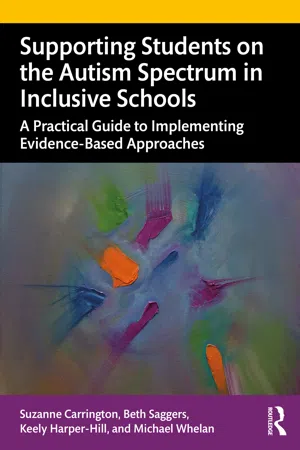
Supporting Students on the Autism Spectrum in Inclusive Schools
A Practical Guide to Implementing Evidence-Based Approaches
- 162 pages
- English
- ePUB (mobile friendly)
- Available on iOS & Android
Supporting Students on the Autism Spectrum in Inclusive Schools
A Practical Guide to Implementing Evidence-Based Approaches
About This Book
Inclusive education has grown as an international movement to not only support students with disabilities but also promote equitable access, participation, and success for all students. This book will transform the capacity of teachers and specialists working with students and families to effectively support an inclusive approach to education for students on the autism spectrum.
This book addresses the urgent need to identify inclusive educational environments and strategies for students on the autism spectrum so that they have the best chance of social, behavioural, and academic success at school. Teachers who include students on the autism spectrum in primary and secondary classrooms require greater knowledge of how they can best support the learning, social, and behavioural needs of their students. Without such knowledge, the consequences can include unsatisfactory learning experiences for all students, and interrupted schooling for the student on the autism spectrum through reduced attendance and retention, lower academic performance, exclusion, disengagement, and pressure on parents to make alternative arrangements for their child's education.
Inclusive education is socially, emotionally, and academically beneficial for all students and positively impacts on respectful attitudes to difference. This book presents innovative, evidence-based practices that will build the capacity of teachers and specialists implementing an inclusive and contextually relevant approach to education that will support students on the autism spectrum and meet the diverse needs of all students in their classrooms.
Frequently asked questions
Information
Part 1
Introduction

1
Moving from a special education model to an inclusive education model
Implications for supporting students on the autism spectrum in inclusive settings – An evidence-based approach
… education systems are trying to move from a special education model to a more inclusive model of practice to support students with a disability in education.
Inclusive education
Inclusion involves a process of systemic reform embodying changes and modifications in content, teaching methods, approaches, structures and strategies in education to overcome barriers with a vision serving to provide all students of the relevant age range with an equitable and participatory learning experience and environment that best corresponds to their requirements and preferences. Placing students with disabilities within mainstream classes without accompanying structural changes to, for example, organisation, curriculum and teaching and learning strategies, does not constitute inclusion. Furthermore, integration does not automatically guarantee the transition from segregation to inclusion.(United Nations, 2016, p. 4)
Table of contents
- Cover
- Half Title
- Cover Art
- Title Page
- Copyright Page
- Dedication
- Table of Contents
- Figures and tables
- Foreword
- Acknowledgements
- Contributors
- Part 1: Introduction
- Part 2: Inclusion and school connectedness: A whole-school approach
- Part 3: Enhancing teaching and the learning experience in the classroom: Impact on educational practice for students on the autism spectrum
- Part 4: Transition to life after school
- Part 5: Conclusion
- Index